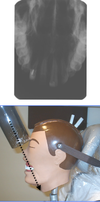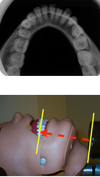JAN 13th Flashcards
(18 cards)
What Mathematical rule is the bisecting angle based on?
The rule of isometry
The bisecting angle technique is based on the geometric principle that states that two triangles are equal if they have two equal angles and a common side
This rule helps us determine the correct vertical angulation to us in order to get equal triangles on either side of the bisecting angle.
If the bisecting angle rule is neglected-(even slightly) the resulting radiographic image will be distorted.
If the vertical angulation of the BID is too large the image will be __________.
Foreshortened

f the bisecting angle rule is neglected-(even slightly) the resulting radiographic image will be distorted.
If the vertical angulation of the BIDis too small the image will be __________
Elongated

Advantages of the Bisecting Angle technique:
- More comfortable for the patient
- Easier to overcome difficult anatomy
- Particularly useful to see apices of lower 8’s
Disadvantages of the Bisecting Angle Technique
Image distortion is more likely due to incorrect horizontal/ vertical angulation
Cone cutting often seen
Receptor is less stable
Periodontal bone levels are poorly shown
Zygomatic arch often overlies upper molar roots
Buccal roots of maxillary premolars and molars are foreshortened
What are the 6 steps for setting up a posterior bisecting angle radiograph?
- Ensure that the occlusal plane is parallel with the floor (for mx: ala-tragus line is parallel to the floor, for mnd: head tipped back slightly so mandible is parallel to floor)
- Position the receptor close to the lingual surface of the teeth
- The vertical angulation of the tube head is then positioned through operator assessment (The central ray is directed perpendicular to the line bisecting the angle formed by the planes of the long axis of the tooth and the receptor)
- The horizontal angulation of the tube head is then positioned using through operator assessment (The flat surface of the BID should be parallel to the horizontal plane of the receptor and the central ray is directed through the interproximal contact areas)
- The x-ray beam is directed through the centre of the area to be radiographed. (The aim is to completely cover the receptor with the beam of radiation to prevent ‘cone cutting’.With the Snap-R-Ray holder ensure that the blue line on the biteblock is just within the BID aperture. Use your finger to line the edge of the BID with the blue line)
- Ensure that the periapical area of interest will be seen. ( Mandibular premolars and molars: 1/4 of the height of the BID aperture is above the Snap-R-Ray biteblock. Maxillary premolars and molars is the opposite: ie 1/4 of BID below biteblock)
Can a patient use their Finger to hold the film?
NO
What is the general verticle angulation that should be used for mx molars and premolars?
+20 to +30 degrees
What is the general verticle angulation for mandibular molars and premolars?
-20 to -30 degrees
What holders do you use for digital bisecting angle radiographs?

What size of receptor for occlusal radiographs is used for adults? Children?
Adults: size 4
Children: size 2
What is the preferred image technique for all periapical radiographs?
Paralleling (XCP)
Patients can usually tolerate anterior paralleling radiographs. If they cannot tolerate posterior paralleling, then use bisecting angle technique.
What are the clinical indications for a Maxillary Anterior Occlusal (Adults) radiograph?
- Periapical assessment of the upper anterior teeth.
- Detection of supernumerary teeth.
- Evaluating lesion size and extent.

What are the clinical indications for Maxillary and Mandibular Anterior Occlusal (Kids) radiographs?
Children < 9 years old (depending on size of mouth) who require a periapical assessment of the upper/lower anterior teeth due to caries/trauma and a standard periapical receptor cannot be placed.

What are the clinical indications for Maxillary Lateral Occlusal radiographs?
- Periapical assessment of the upper posterior maxillary teeth in adults who cannot tolerate periapical images.
- Evaluating the size and extent of lesions in the posterior maxilla
- Assessing the antral floor
- As an aid to determining the position of displaced roots into the antrum
- Assessment of fractures of post teeth, alveolar bone, tuberosity

What are the clinical indications for a Mandibular Anterior Occlusal (Adults) radiograph?
- Periapical assessment of the lower incisor teeth in adults unable to tolerate a periapical image.
- Evaluation of the size and extent of lesions in the anterior mandible
- Assessment of mandibular fractures.

What are the indications for a Maxillary Standard Occlusal radiograph?
Detecting the presence of unerupted canines, supernumeraries.
Evaluation of the size and extent of lesions.E.g cysts, tumours
Evaluating fractures

What is are the clinical indications for a Mandibular True Occlusal radiograph?
- Detection of salivary calculi.
- Assessment of the bucco-lingual position of unerupted mandibular teeth.
- Evaluation of the bucco-lingual expansion of the mandibular body.
- Assessment of fractures



